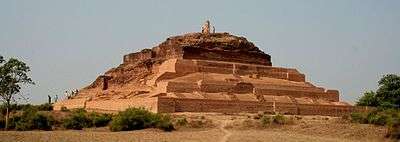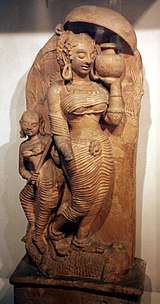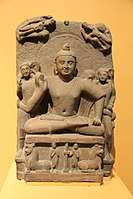Ahichchhatra
Ahichchhatra (or Ahichatra, Ahi-Kshetra), near the modern Ramnagar village in Aonla tehsil, Bareilly district in Uttar Pradesh, India, was the ancient capital of Northern Panchala, a northern Indian kingdom mentioned in the Mahabharata.


Most of the city was half a mile north-east of the modern village, with a large mound, popularly called the fort, two miles west of this. Several significant finds of sculpture, in both stone and (especially) terracotta of the early centuries CE, have been made at the site and are now in various museums. Excavations have uncovered nine strata, the lowest from before the 3rd century BCE and the latest from the 11th century CE.[1]
The city appears to have reached its height during the period of the Gupta Empire. The region lacks sources of good stone and was a centre for making Indian pottery at various periods, and in the early CE the temples were decorated with unusually large terracotta relief panels and sculptures, many of very high quality.[2]
Names
The word Ahi means snake or Naga in Sanskrit. Nagas were a group of ancient people who worshiped serpents. The word khsetra means region in Sanskrit. This implies that Ahi-kshetra was a region of Nagas.
Ahikshetra is mentioned as Shankavai Samkhyavati in Vividhatirthakalpa.[3]
History
Its history reaches back to late Vedic times, at which time it was capital of the Panchala kingdom. The name is written Ahikshetras as well as Ahi-chhatra, but the local legend of Adi Raja and the Naga, who formed a canopy over his head, when asleep, shows that the later is the correct form. The fort is said to have been built by Adi Raja, an Ahir, whose future elevation sovereignty was foretold by Drona, when he found him sleeping under the guardianship of a serpent with expended hood. The fort is also called Adikot.[4]
The territory under Ahichchhatra was formerly under the Panchala king Drupada. Later it was taken over by Drona, after a war, in which Drupada was defeated by Drona's disciple Arjuna. Ashwatthama, the son of Drona, was given the responsibility of ruling the territory of Northern Panchala from Ahichchhatra. Ashwatthama probably ruled the kingdom being subordinate to the rulers of Hastinapura.
Archaeology
The site was briefly explored by Sir Alexander Cunningham in 1871, and then excavated by the ASI from 1940 for "about five years".[5] The excavations found brick fortifications and continuity of occupation from a period before 600 BCE to 1100 CE.[6] During the first excavations in 1940–44, the Painted Gray Ware pottery were found at the earliest level. Ruins of this city could be identified from the remote sensing imagery of IRS (Indian Remote Sensing) satellites. The ruins reveal that the city had a triangular shape. Recent excavations in Ahichchhatra showed it was first inhabited by the middle of the second millennium BC with Ochre Coloured Pottery culture people, followed by Black and Red Ware culture. Around 1000 BC, it reached at least 40 hectares of area, making it one of the largest Painted Grey Ware culture sites. Evidence of construction of early fortifications were discovered around 1000 BC indicating first urban development.[7][8] Near Ahichchhatra, 2 km to its west there is a big pond which is said to trace its ancestry to the time of Mahabharata. The pond, located in the village of Jagannathpur is said to have been made by the pandavas at the time of their forest dwelling (vanvas).
In the early Gupta period a section of the city set aside for pottery contained very large firing pits, some 10 or 12 feet deep.[9]
Jain tradition
Ahikshetra is an important religious place for the followers of Jainism in India. Jain literatures cites this as a place where Parshvanatha attained Kevala Jnana [10]
Means of approach
From the Revati Bahoda Khera Station on Chandosi – Bareilly Line, vehicle of Kshetra and other vehicles are available. Road: - Buses are available from Delhi, Meerut, Aligarh, Lucknow, Kasganj & Badaun. Train: - Trains are available from Delhi, Bareilly, Agra, Muradabad, Aligarh to Revati Bahoda Khera Station and vehicles are all time available for Ramnagar from Revati Bahoda Khera Station. Airport: - Delhi 250 km
Nearby Places
Nainital – 180 km Hastinapur Atishaya Kshetra – 200 km Kampilji Atishaya Kshetra – 180 km Manglayatan (Aligarh) – 180 km Bareilly – 55 km
Sculpture from Ahichchhatra
 Stone Buddha, c. 1st Century CE, Kushan Period
Stone Buddha, c. 1st Century CE, Kushan Period.jpg) Sandstone Shiva, 3rd century
Sandstone Shiva, 3rd century.jpg) Terracotta architectural panel with Goddess, Gupta period, 5th century
Terracotta architectural panel with Goddess, Gupta period, 5th century Gupta period terracotta Yamuna, pair to the Ganga above
Gupta period terracotta Yamuna, pair to the Ganga above
Notes
| Wikimedia Commons has media related to Ahichchhatra. |
- Kala, p. xv
- Majumdar, 429-430
- Subodh Kapoor 2002, p. 16.
- Subodh Kapoor 2002, pp. 17-19.
- Kala, p. xv
- Lahiri, Bela (1972). Indigenous States of Northern India (Circa 200 B.C. to 320 A.D.), Calcutta: University of Calcutta, pp.170-88
- "What Lies Beneath".
- http://www.educationtimes.com/article/290/20130917201309171524062507304cdb3/What-Lies-Beneath.html What lies Beneath, B. R. Mani 2013
- Majumdar, 430
- "Shri Ahichchhatra Parshvanath Atishaya Kshetra, Ramnagar | JainTeerth.com". Retrieved 22 December 2019.
References
- Kala, Satish Chandra, Terracottas in the Allahabad Museum, p. xv, Abhinav Publications, 1980, ISBN 0391022342, 9780391022348, google books
- Kapoor, Subodh, ed. (2002), Encyclopaedia of Ancient Indian Geography, 1, Cosmo Publications, ISBN 81-7755-298-8
- Majumdar, Ramesh Chandra, Vakataka - Gupta Age Circa 200-550 A.D., 1986, Motilal Banarsidass Publ., ISBN 8120800265, 9788120800267, google books